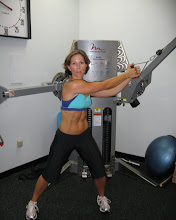After sending out my newsletter yesterday I received a lot of questions asking...if Afterburn is not for inseason and only for offseason, what do you recommend triathletes do for their strength training leading up to a race?
I think many triathletes probably fall into the trap of using body builder routines in the gym. I just heard a competative triathlete the other day say, "I went to the gym and did deltoids and then 2 hours on the spin bike." Deltoids? This cracked me up- who has time, not that it is even beneficial, as a triathlete to train each muscle seperatley right down to deltoids getting their own day? Let alone WHY would you want to isolate your deltoid muscle- which sport in triathlon uses the deltoid all by itself without any other muscles working? Which sport in general? There isn't one! If you are splitting up your body parts you are following a bodybuilder program and it will make your triathlon performance worse. This type of program is what scares a lot of triathletes away from lifting weights, because they see that you get big, bulky and completely non functional by lifting weights. But it is a mistake to think that getting strong means getting huge, bulky muscles. Unless your goal is to have nice looking deltoids when you cross the finish line last do not split up your body parts and train like a body builder.
The goal with strength training for triathletes is to get strong without gaining any unwanted mass. Strength does not mean size. You need to improve your functional strength, which is a combination of stabilizing exercies and power exercises. Having functional strength will benefit your performance by giving you power and endurance and keeping you injury free.
You HAVE to train your body to work as one unit and use movements not muscles in the gym. Use full body routines. You use your full body in your sport, why wouldn't you train it in the gym the same?
So, if full body is the way to go- why wouldn't afterburn work during the season? Afterburn is too high in volume and burns way too many calories which is why it will get you so lean but when you are training for a race you need to save all of that energy for your other training. Use afterburn in the offseason when you don't have a race coming up to shed body fat.
Less is more. I have found, through using myself and my training partner as guinea pigs, using a routine that takes at most 30 minutes and can be performed right before we head out on our bikes or for a run or off to the pool works best. This routine is not so intense we have nothing left to give(Afterburn) our other workouts but instead it warms us up, switches on all the right muscles, strengthens the weaker muscles and lengthens the shorter muscles while increasing core strength, elastic power, balance and stability. It does not require a ton of recovery and wipe us out for the next day.
We have two different routines. We start both routines with movement prep which is dynamic exercises to warm up our joints and lengthen our muscles. This gets us warm, switches on our muscles and ready to train. We also have a seperate day that we spend 30-40 minutes foam rolling and stretching, a rejuvenation workout.
Routine One focuses on Strength and stability. Especially in our hips, core and shoulders which are extremely important in triathlon and need to be strong to deliver power and to decrease any potential for injuries. We do a circuit of 6 exercises for 10 reps each including core strengthening, hip strengthening and shoulder strengthening exercises. We do 2 rounds and we are done. So 12 sets total.
Routine Two focuses more on corrective exercises and Power. We start off with a circuit of 6 corrective exercises again strengthening the hips, core and shoulders for 10 reps each. We finish with a circuit of 4 power exercises to increase our elastic power, or our ability to store and release energy. These power exercises are all plyometric exercises bounding, hopping and jumping. So in this routine we end up with 2 sets of 6 exercises in the first circuit and 2 sets of 4 exercises in the second circuit so we do a total of 20 sets. It still takes us less than 30 minutes to get through. Anymore than that and you are doing too much!
Our routines were modeled after some of the routines in the book Core Performance Endurance. Mark Verstegen has two programs in the book that you can use similar to what I have been doing.
skip to main |
skip to sidebar
closeupsmaller.jpg)


Best Selling Author of The Female Body Breakthrough(Rodale, Nov. 2009), Women's Health Columnist, Owner of Results Fitness in Southern California, and your Fit Female Coach.
The Female Body Breakthrough's Fan Box
closeupsmaller.jpg)
New Ultimate Core DVD Available! Order Your Copy Today!
Only $34.99!
Click Here to get your copy!
QUOTE OF THE DAY
Ironman Finisher 2007


Blog Archive
-
▼
2007
(72)
-
▼
February
(19)
- Recovery
- Transitioning...
- Wetsuits and funny looks.
- Week at a glance...
- Bad timing to be sick!
- Visualization...Training weekend Part Three
- Training Weekend Part 2
- Life is too short...
- 3 days a week
- To train or not to train?
- What's to eat?
- A lot can change in 25 miles...
- The Triple Layer Brick Sandwich
- Because Dave Scott says so....
- Coffee, Coffee, Coffee
- Pacific Shores Marathon Recap
- Week at a glance...
- Strength Training for Triathlon
- Act as if...
-
▼
February
(19)
